English
Schools' Concert 'DARWIN Explore!'
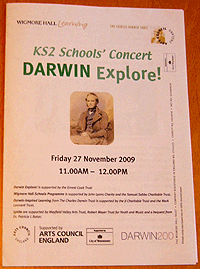
Programme of 'Darwin Explore!'
Wigmore Hall invites primary school groups to the hall to host one-hour-long schools' concerts several times a year. Sometimes, it focuses on particular music genres and instruments, such as jazz or percussion, and, at other times, they connect curricula, such as music and history, by learning about the music and culture of different periods through its dance, costume, and so on. This time, the topic was 'Darwin', combining history and natural science.
Title: Schools' Concert 'DARWIN Explore!'
Date: Friday 27th November 2009, 11:00-12:00
Venue:Wigmore Hall
Ensemble: Ignite (Vibraphone, flute, clarinet, violin, cello, double bass)
Target: Keystage 2 (7-12 years old)
Fee: £2 per person, only for school groups
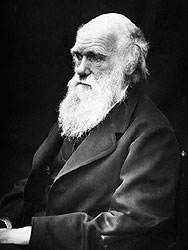
Charles Darwin
The year 2009 marked the bicentenary of the birth of the British scientist, Charles Darwin (1809-1882), and many 'Darwin200' events took place at the Natural History Museum, on television and in various places across the UK. For British people, Darwin is not only a world-famous scientist, but also a great figure who represents their history. Wigmore Hall also featured Darwin in one of the schools' concerts.
The project named 'DARWIN Explore!' was planned in cooperation with the Charles Darwin Trust. It was targeted at keystage 2 school groups; middle to higher grade of elementary school in Japan. About 350 students from 10 schools attended the concert, half of whom also took part in the prior workshops.
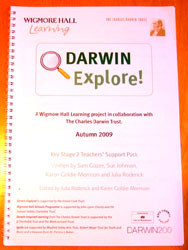
Resource Pack for the workshop
Elizabeth from the Learning team told me that, 'The students who attended the workshops knew what they could expect during the concert, and seemed more actively involved in the concert. This is an attempt to collaborate with 'Natural Science', but more and more schools in the UK are interested in cross-curricular programmes recently'.
On the day of the concert, the hall was packed with school-children and their teachers. The music workshop leader, Sam, acted as the presenter, talking about Darwin and introducing the music in turn smoothly: 'The great scientist, Charles Darwin, was not a good student as a boy. Instead, he liked to go outside and collect plants, rocks and insects', Sam started the tale. 'Can you imagine how little Darwin explored the garden and went home tired at night?' This was followed by the first tune by Ignite.
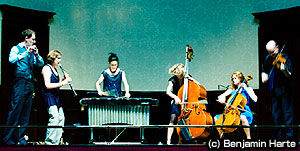
Ignite
Inspired by the tale, the children listened to the music enchanted, visualizing their own image of the boy, Darwin. Praising them, he exclaimed 'What brilliant listening!', and continued, 'Finishing university, Darwin was not sure what to do for a job. Then, he was invited on a long sea voyage to South America, as captain's assistant of HMS Beagle. Persuading his father, he set sail on a five-year voyage around the world'.
Sam asked the children, 'What would he feel like being on a ship for a very long time?' They answered, 'He would become seasick!' He replied, 'Yes, in fact, we could see in his diary that he was so miserable being seasick and suffering from rotten food,' and they said, 'Ah, poor Darwin!' Then he cheered them up saying, 'Now, I will teach you a sea chantey that would lift the sailor's feelings!' and sang "Blow Ye Winds Of Morning" phrase by phrase, accompanied by Ignite, and the children copied it. To help them to remember the lyrics, he acquired ideas from them about gestures, like pulling on a rope. At last, Sam sang the melody with the lyrics borrowed from Darwin's diary, and everyone else joined in with the main tune with gestures.
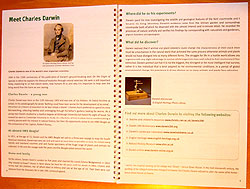
Inside of Resource Pack
The story went on: 'Finally, the Beagle arrived in South America. Just like this, European culture also landed there, so that is why we can see the link in music between Europe and distant South America'. Then the children listened to and compared three pieces: a sonata by the Spanish composer, Jose Pla, a tune with a similar motif which has come from Bolivia, and a newly composed piece by Ignite that is inspired by Bolivian music. In that way, they could feel the cultural atmosphere better than just hearing the word "South America". Listening to the exotic music, they also heightened their concentration when the music mood changed.
'Landing in South America, Darwin discovered a lot of things. He observed different kinds of birds in the Galapagos Islands closely, and found that some of the birds were almost exactly the same except for their beaks. Have you ever observed birds carefully? What sounds do birds make?' asked Sam. One of the child whistled, another one made a whooping sound by blowing into their hands, and another made the sound of wings flapping by rubbing their hands together. Saying 'Let's make our own Birdsong using these sounds!', Sam gave the audience signals about when and which sound they should make, and conducted the music, just combining those sound patterns. Then they listened to what Olivier Messiaen composed as birdsong.
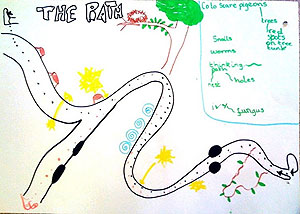
The Graphic Map/ Score' The Path'
Sam said, 'Returning from the journey, Darwin thought about the things that he had seen on the islands; plants, rocks and birds. This led him to develop his famous theory of Natural Selection, and publish "On the Origin of Species". While Darwin devoted himself to thinking, he walked around the garden for hours. I believe that some of the school groups here had tried Darwin's way of thinking'. In the workshop by the Charles Darwin Trust, the children strolled around the King Henry's Walk Garden and observed the nature surrounding them. The graphic maps, on which one of the groups drew what they had spotted during their strolls, were hung all over the hall: When you walk along the path, you encounter trunks, big holes, snails, bird's nests, and ivy.
When Sam told the children 'I think we can make music entitled "The Paths" using this "Graphic Map" as a "Graphic Score"', they looked puzzled and asked 'How?' He gave it a try: 'Well, you can see these black footsteps coming along the upper path, and other pink footsteps approaching from the bottom. Which instruments do you want to represent them?' As the children designated the male flutist for the black footsteps, and the violinist for the pink one, each instrumentalist devised a short music pattern as if he were walking slowly, thinking. He continued the path: 'There's a trunk on the side of the path. Who should play it?' 'The cello!', one boy shouted. In this way, they combined the instruments and what they found in the garden: a bass clarinet for snails; a vibraphone for birds' nests; a double bass for the big holes; and the whole audience for the ivy.
Finally, all of the audience and the musicians started to make music on the spot. Sam conducted the music by reading the 'Graphic Score' and pointing at each musician at the right moment: 'The black footsteps are walking slowly along the path...He's spotted a trunk, oh, there are two more. Watch out! There is a big hole...Look at that! There are three snails underneath the leaves'. Then, the bass clarinetist played the pattern of snails three times. When hearing, 'Oh, there is a tiny one, too!', she played the same pattern in a higher pitch. Having reached the end of the garden, Sam shouted, 'Let's get back quickly!', and they played the score backward at a faster tempo.
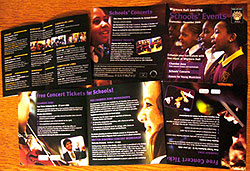
Brochre for Schools' Events
'Cool!' The children were excited to witness the moment when the music was made out of their drawings of their discovery while observing nature, using the sounds that they had chosen. The one-hour concert was not just about playing music on a certain theme, but also a mixture of various activities: imagining the story while listening to the music, comparing the music, learning new songs and singing them, transforming what they discovered in nature into music, and making music with the sounds they chose and performing it.
The method of collaboration between different curricula can be varied. This time, the two workshops were combined by exercising Darwin's method of thinking in nature, and showing its outcome in the form of music in the concert hall. Although each curriculum is normally separated, all of them should be digested and remain together in a child. It must be one of our important missions in education to show children various ways of making links between them in order to foster their coexistence.
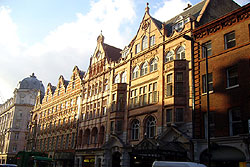
Wigmore Hall
---Concert Programme---
1. Stephen Warbeck: November
2. Traditional: Blow Ye Winds Of Morning
3. Jose Pla: Sonata No.4 Allegretto (from Six Sonatas)
4. Anonymous: III. Allegro (from Folias)
5. Ignite: Bolivian Remix
6. Olivier Messiaen: Abisme d'oiseaux (from Quartet for the End of Time)
7. Luke Bedford: Self-Assembly Composition No.1
8. Jackie Walduck: Hot Foot Frenzy
Report: Chigusa Futako








